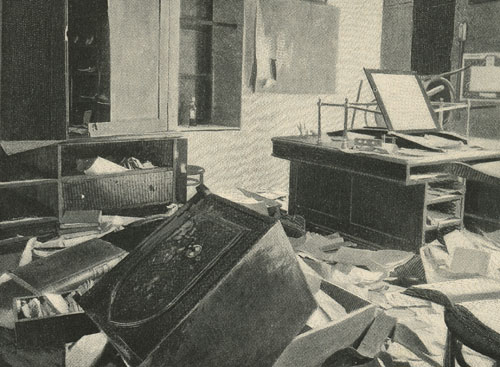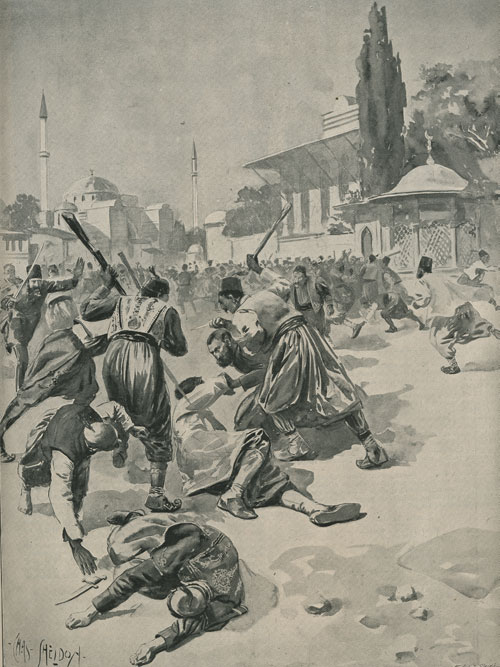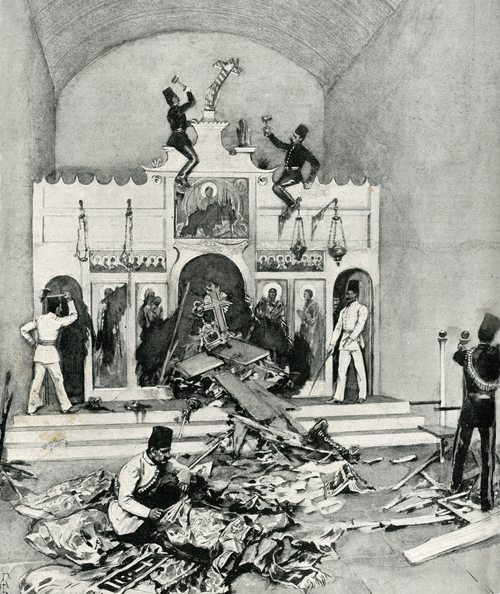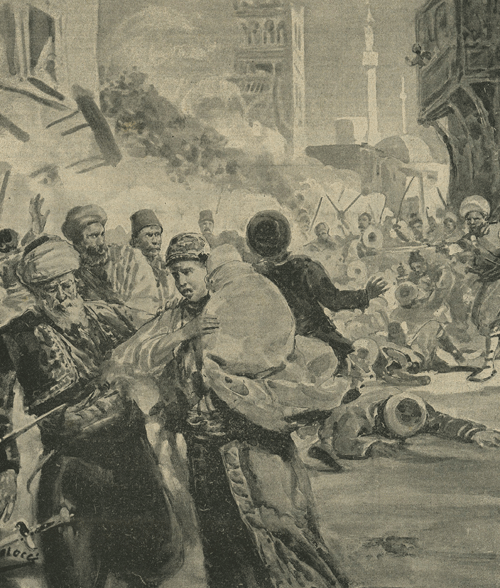|
1895/96 Armenian Issues
The Armenians in the Turkish Empire
The Ottoman Empire, in addition to the Turks, included numerous minorities. Among them were
Kurds, Greeks, Jews, and Armenians. Most of the businesses such as shipping, banking and
manufacturing were in the hands of the Greek, Jewish and Armenian minorities.
The Armenians over the centuries had
been good citizens of the sultans. One of the nineteenth century sultans
even declared the Armenians his "most loyal millet"
(A millet is a national or religious group with in the Ottoman Empire).
However, the Moslems looked upon the non-Moslem groups as "cattle"
or "gaiour". Non-Muslims were not
granted
the liberties and political rights of the believers.
They were in fact second-class citizens.
Because of the religious and financial situation, there was a level of animosity towards
the non-Turkish minorities.
Massacre of Armenians in 1895
There were numerous massacres in 1895 in which an estimate 100,000 to 200,000
Armenians lost their lives. These including:
Massacre of Armenians in Constantinople in 1896
In order to draw attention to the situation of the Armenians in Anatolia, on August 26, 1896
a group of twenty five Armenians seized control of the Ottoman Bank
in Constantinople. They treatened to blow up the bank unless their greivances were addressed.
They received safe conduct to a French ship in the harbor. After their departure there was
a massacre of Armenians in the
Galata commercial
quarter. The attacks which included widespread looting lasted two days and eventually
spread to the Armenia section of the
Jewish quarter. The Armenian population of both these quarters was almost completely
wiped out. It is estimated that five to six thousand Armenians were killed. The carnage was
finally stopped when British troops moved in obstenibly to protect British lives and property.
Many Armenians in the city emigrated within a few months of this incident.
Abraham and Lucy were married in the Beyoghle section of Constantinople in 1895. Their
daughter, Catherine was baptized in October 1896 in the same church as the marriage but the
address listed was
Galatia. I do not know what the family did during this difficult time.
The family never mentioned the incidents of 1896.
Massacre of Armenians in Adana in Cilicia in 1909
There was an incident in
April (13th-16th) 1909 of anti-Armenian
demonstrations
in Adana in Cilicia. The government in Constantinople sent two divisions of solders to
quell the disturbance. On April 24, before the troops arrived, new hostilities broke out.
The regular army units in the area, opened fire on the very crowded Armenian quarter,
and hurled firebombs into it. About 200 small villages in the area were burned and
plundered. The number of Armenia deaths was estimated to be about 30,000.
It is not clear whether these atrocities occurred with the sanction of the government
or were totally independent of the government.
Constantinople August 1896
The events of the August 1896 "Armenian Riots" instigated by the seizure of the Ottoman Bank in
Galata were recorded in Scribner's Magazine under the title
A Bystander's Notes Of A Massacre, The Slaughter of Armenians in Constantinople by Yvan Troshine.
The following information is from the Scribner's article:
Around one o'clock in the afternoon there were several large explosions in Galata.
These were followed by shots "fired in rapid succession".
The end of the bridge at Galata was barred by troops so Mr. Troshine went to the office of a
friend in Stamboul (the Moslem section of the city). From this building he could look
across the bridge with a telescope and see the bank. Soldiers were all around the bank
firing towards it. Wild stories began to circulate including that "the bank had been attacked
by Turkish troops who were tired of waiting for their pay".
Eventually a man arrived who had been in Galata and reported that the Bank had been seized by a
group of Armenians who were going to hold it until the Sultan granted their demands for an
autonomous Armenia.
"By four o'clock reports began to come in that Armenians had been killed while
peaceably walking the streets."
At this point most of the shopkeepers closed up shop and almost everyone headed for home.
Mr. Troshine and a friend walked toward the bridge to try and take a steamer for the Bosphorus
and get away from the city.
"Numbers of Turks were assembled at the street corners, many of them
carrying clubs or rough billets of wood. But we saw no violence toward any Christian.
Troops were scattered along the street in parties of ten or twelve. There seemed good reason to
hope that they would prevent mobs from forming to attack Christians."
The year before a Turkish mob had killed many Christian in Constantinople. It was hoped that
the government had learned from the storm of indignation after these attacks and would
do what ever was necessary to prevent a reoccurrence of the year before. If the government won
control of the mobs and did not allow any further massacres of Christians the sympathy of the
Europeans would be with the Turks and not with the Armenian "terrorists".
However, the troops chose to ignore the massing Turkish mobs that started killing
"Armenians of the poorer class, who had been killed, not with weapons, but by beating with
clubs".
The corpses were "indecently" piled like "offal" in scavenger carts and pushed through the streets
for all to see.
As they arrived at the bridge, Mr. Troshine and his friend, came upon an
awful sight.
"Men were at work gathering dead bodies of Armenians out of the water.
Almost immediately upon the outbreak at the Bank the Kurdish porters employed at the
Custom-House on the Stamboul side of the harbor, more than a mile from the scene of disturbance,
had killed all whom they could catch of their Armenian associates, and had thrown them into the
sea. The police were now having the bodies dragged from the water in order to be
taken away by the carts; and some of the wretches were still alive."
These "poor fellows" were attacked by a mob with clubs and beaten to death while the police
stood by. Only after the Armenians were dead did the police disburse the mob. Instead of
arresting the murderers they let them get away and simple called the scavengers cart to take
away the dead.
"Turkey had learned nothing from the indignation of the world at the massacres of the last
year"
Later encounters between Mr. Troshine and some Armenians and Greeks revealed that some
Armenians were allowed to pass unharmed and were even assisted by the police to move through the mobs. While on the steamer up the Bosphorus Mr. Troshine learned that:
"Even the Armenians who had found their way to the steamer to go to
their homes in the upper Bosphorus testified that no one had molested them or made
them afraid." However, it was clear that the lower classes of
Armenians were being killed
"wherever they were found, notwithstanding the fact
that no outbreak had occurred in Galata or Pera besides the one at the Bank".
It as reported that almost immediately after the first explosion at the Bank gangs of
Turks formed in the area and armed themselves with clubs. Those without clubs broke up tables
in local cafes to supply themselves with some form of weapon. Instead of going towards the
Bank some 300 hundred of them made off down the hill toward Cassim Pasha where numbers
of Armenian workmen from the eastern provinces lived. The next day's news revealed that
some hundred of poor Armenian workmen in Cassin Pasha had been beaten to death.
There had also been attacks on Armenians houses at Samaria, Ballad, and the region of the
Adrianopolis Gate (areas near the "revolutionist outbreak").
Several hundred men were
killed in the Armenian Quarter of Hasskeuy on the other side of the Golden Horn.
The women of the quarter were unharmed. Houses were pillaged. "There was no Armenian outbreak
to provoke this terrible slaughter"
The revolutionaries in the Bank surrendered
during the night.
As it turned out twenty-four young Armenians from abroad and two Russian Armenians were involved
in the bank incident. Some entered the bank as if to deposit bullion, which was
carried in bags on the backs of porters. Others remained outside waiting for a signal.
Bombs were set off and shots fired by both sides. There were over a hundred bank
employees held captive by the Armenians. Demands were made that
"The Sultan agree to executer the Reform Scheme of 1875 under European supervision,
that there be no promiscuous massacres in the city on account of the outbreak;
that the members of the band in possession of the Bank be given safe conduct out of
the empire, and that pending negotiations the troops be withdrawn from the vicinity of the Bank."
After several hours of discussion, it was agreed that the Sultan would consider the
question of reform and the revolutionists would be given safe conduct out of the empire.
Not only were they given save conduct out they were given money "to spend in France on arrival".
Things appeared quite in the morning but the city remained shut up. Not even the tobacconists and
the water sellers were working.
There was blood on the streets and indications that many shops had been broken into and
pillaged.
"Not an Armenian was to be seen, and what few Christians of other race
ventured upon the streets sought to diminish the temptation which their presence might
offer to the mob by making themselves as inconspicuous as possible in the depths of cabs.
Everywhere the bludgeon-men were standing about or sauntering along in groups."
The mobs were made up of the lower classes: "the better class of Turk were none among them".
A walk though Galata showed a considerable number of business offices and
stores belonging to Europeans which had been entirely sacked; the desks and files ransacked,
the furniture broken, and all portable valuables carried off, while the safes were taken
from their places and turned upside down in the attempt to find a vulnerable spot,
but in most cases abandoned unopened after sledge-hammers had smashed every projecting point in
vain."
The Turkish government maintained that only Armenians engaged in revolutionary activities
were murdered yet the author recounts numerous instances where people where killed in cold
blood for no other reason than that they were Armenian while the police looked on and did nothing.
The atrocities spread outside of the city to village along the Bosphorus where
Armenian houses were pillaged and a number of Armenians killed.
The British Charge d'Affaires, after viewing the pillage of the offices of Englishmen,
ordered a force of British marines ashore to protect English property. Several
ambassadors met and sent a collective telegram to the Sultan telling him that they were
forced to order armed marines ashore for the protection of the embassies.
The Sultan at last had ordered the massacre to stop. However, firing and looting continued
all over the city until about 8 o'clock at night when it suddenly stopped. By Friday morning
the police were maintaining control and dispersing the mobs.
"There will never be any trustworthy report of the number of Armenians
killed during the thirty-six hours of massacre of Constantinople. Some of the
officials seem to have two sets of records- both equally wrong. One report was prepared
for the Sultan's eyes. In the hope of commendation for zeal in repressing rebellion,
actual and possible, it places the total of Armenian dead at more than eight thousand.
The other report was made out for consumption in Europe. In the hope of convincing
the world that nothing had occurred worthy of condemnation. It decries the number of
Armenian dead to be eleven hundred. The actual fact, probably, is that between four
thousand and six thousand persons were killed for sheer hate of race, besides any few
scores of actual revolutionists who may have fallen through their own folly. Of Turks,
military and civilian, their own authorities say that less than one hundred and fifty
were killed. Nevertheless the official documents declare that the whole of these disorders
were the work of Armenians. So far as the Turkish official utterances are concerned, not
one particle of regret, of shame, or remorse is felt for the destruction of these
thousands of helpless creatures."
Catholic Armenians
"The actual fact as to the principle on which the authorities acted, I believe
was unconsciously revealed by the words of a high police official with whom I
had occasion to talk of the danger which even Europeans might incur should mob rule be
prolonged. He said, "We have orders to protect all foreigners. In fact we have instructions
also to protect Greeks and Roman Catholic natives. If you have friends among them who are
alarmed, you may tell them confidentially of this fact. But you must tell it to them very
confidentially, for if the Armenians should hear of it they would all be calling out "I am a
Catholic, or I am something else", and demanding to be protected."
It is not clear how the Turks would know a Catholic Armenian from any other Armenian.
1896 Armenia and Its Sorrows
The book Armenian and Its Sorrows was published just before the events of October 1896. In the
second addition some comments were added about the events of October 1896 in Constantinople.
"Within two hours every street in the lower part of Galata was
literally flowing with Christian blood. The troops were quickly on the scene to
regulate the traffic, but never made the slightest attempt to check the murderous proceeding of
the Mohammedan populace.
The afternoon and evening were devoted to scenes of carnage, and all though the night the
mob took free vengeance on the Armenians, murdering, wrecking houses, and pillaging shops,
while the authorities exercised no restraint upon them. The number of persons killed between
Wednesday and Sunday is estimated by the Embassies at between five thousand and six thousand
largely belong to the class of street porters. About a thousand more are missing."
|



